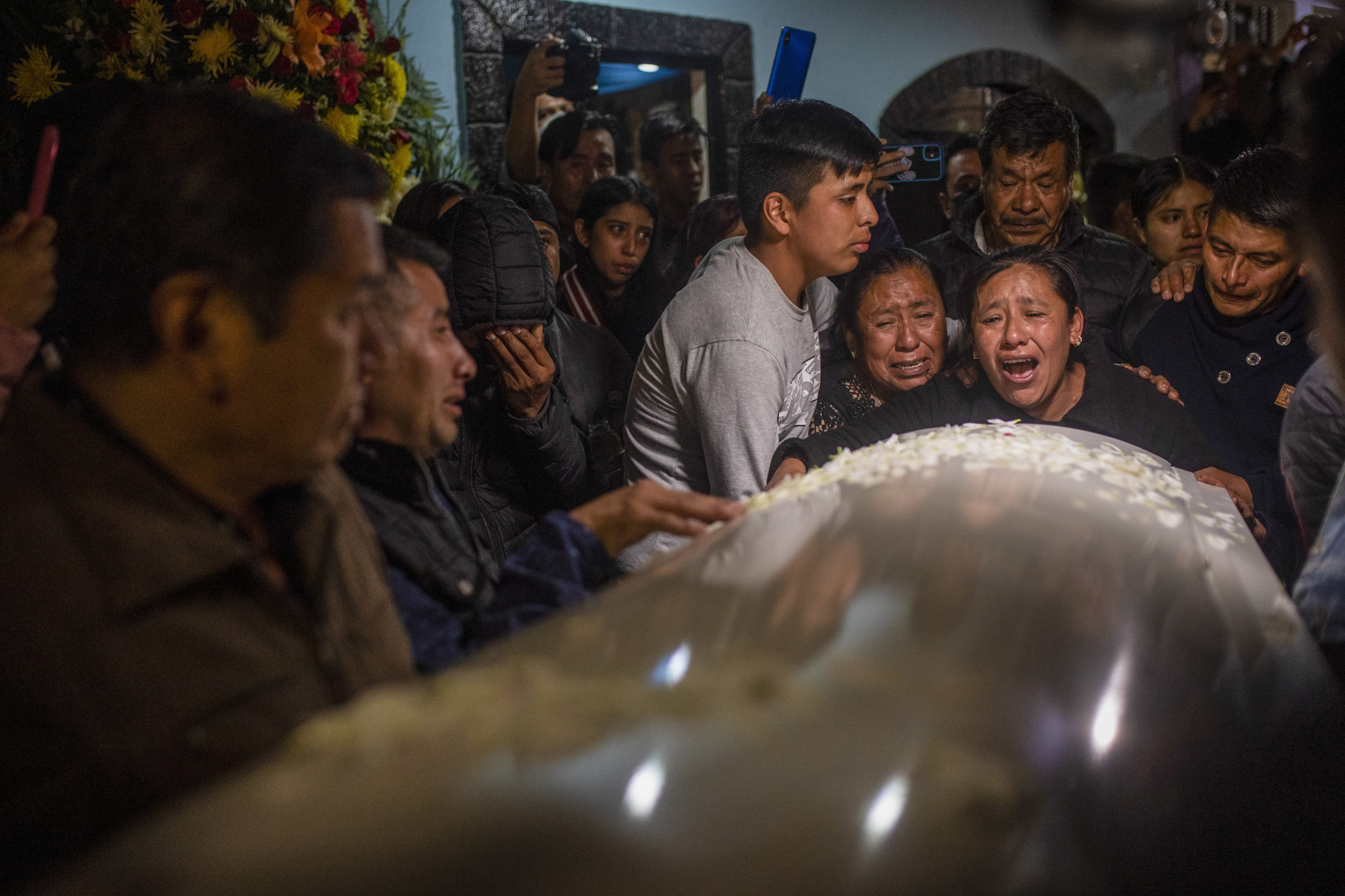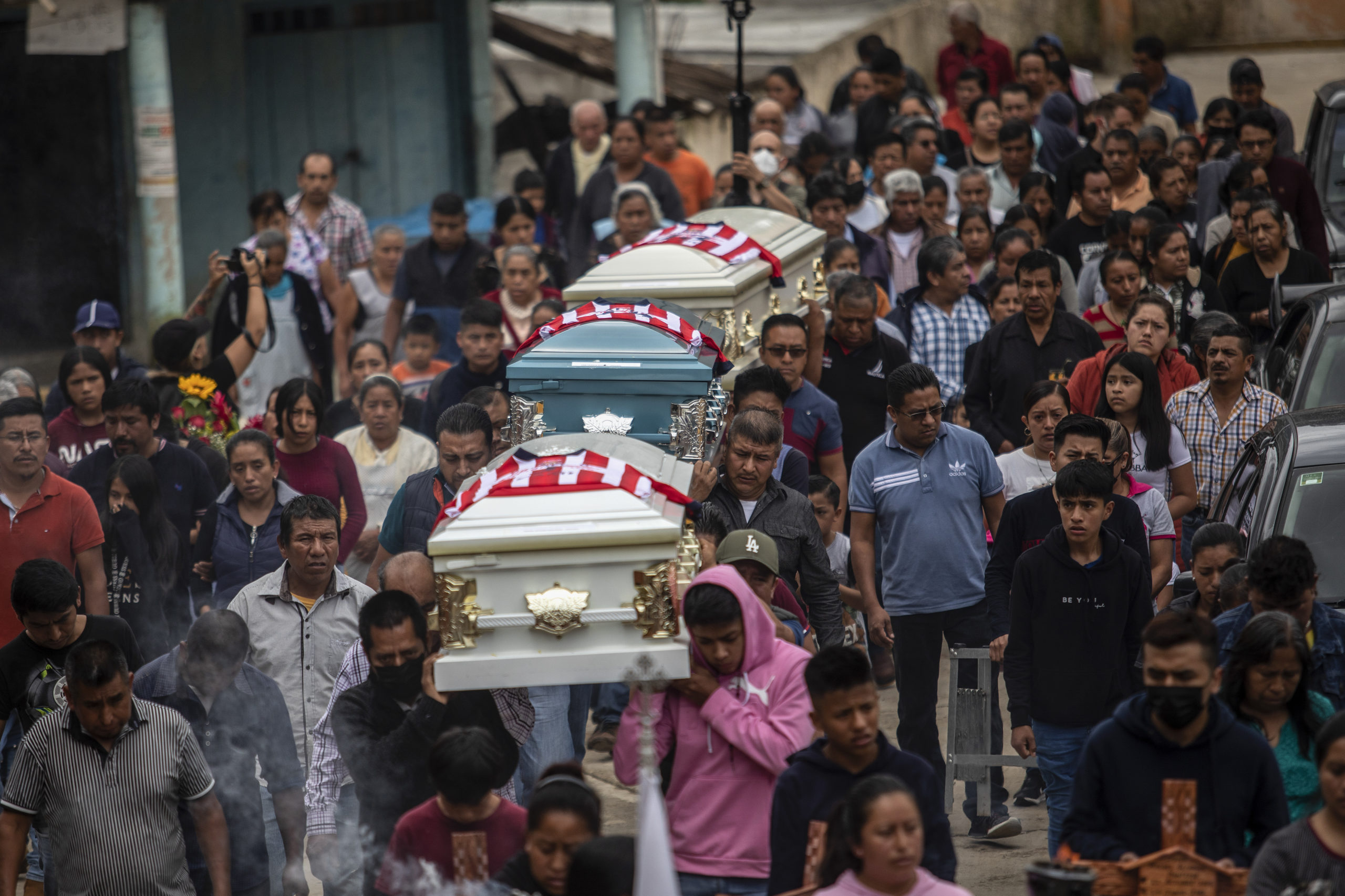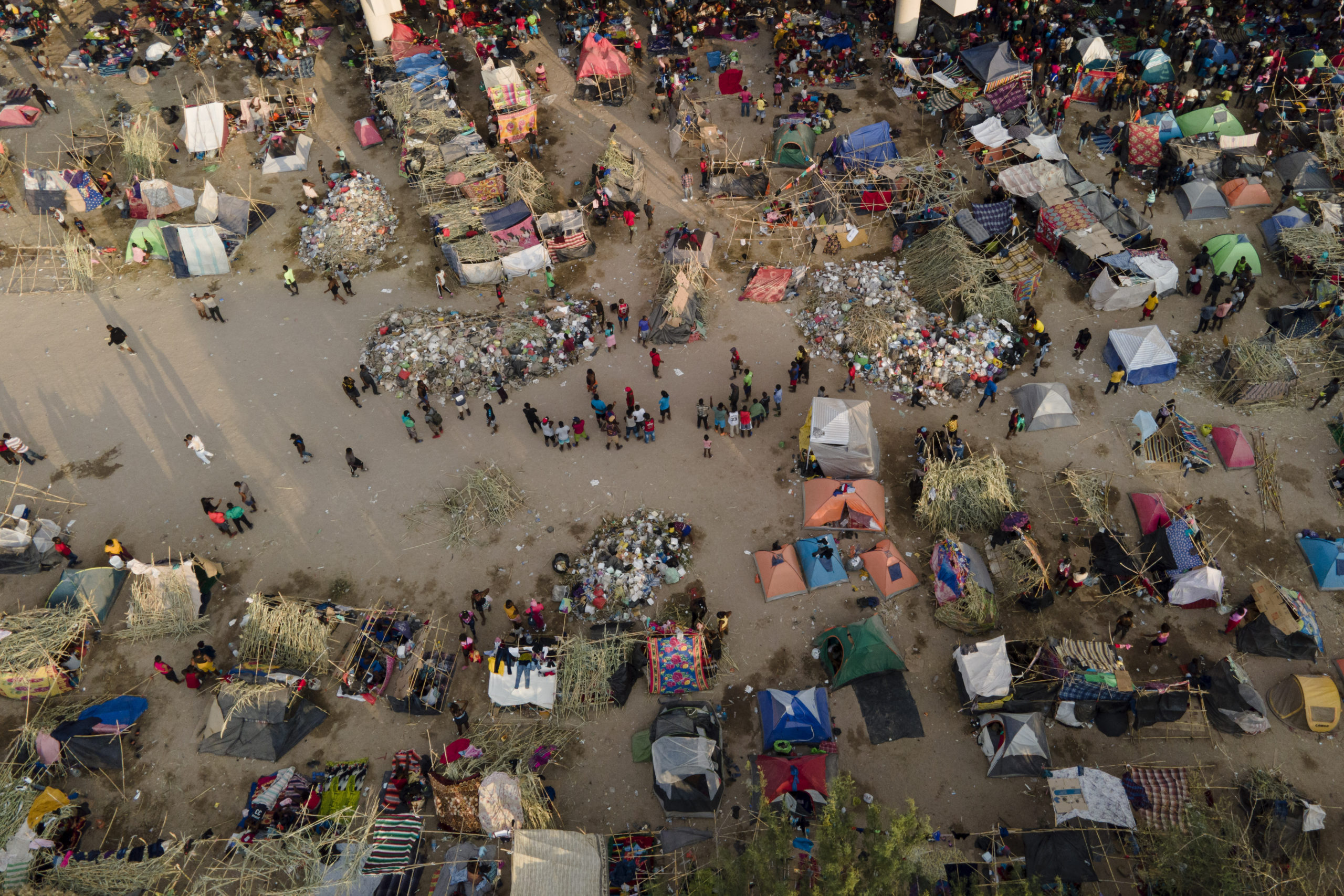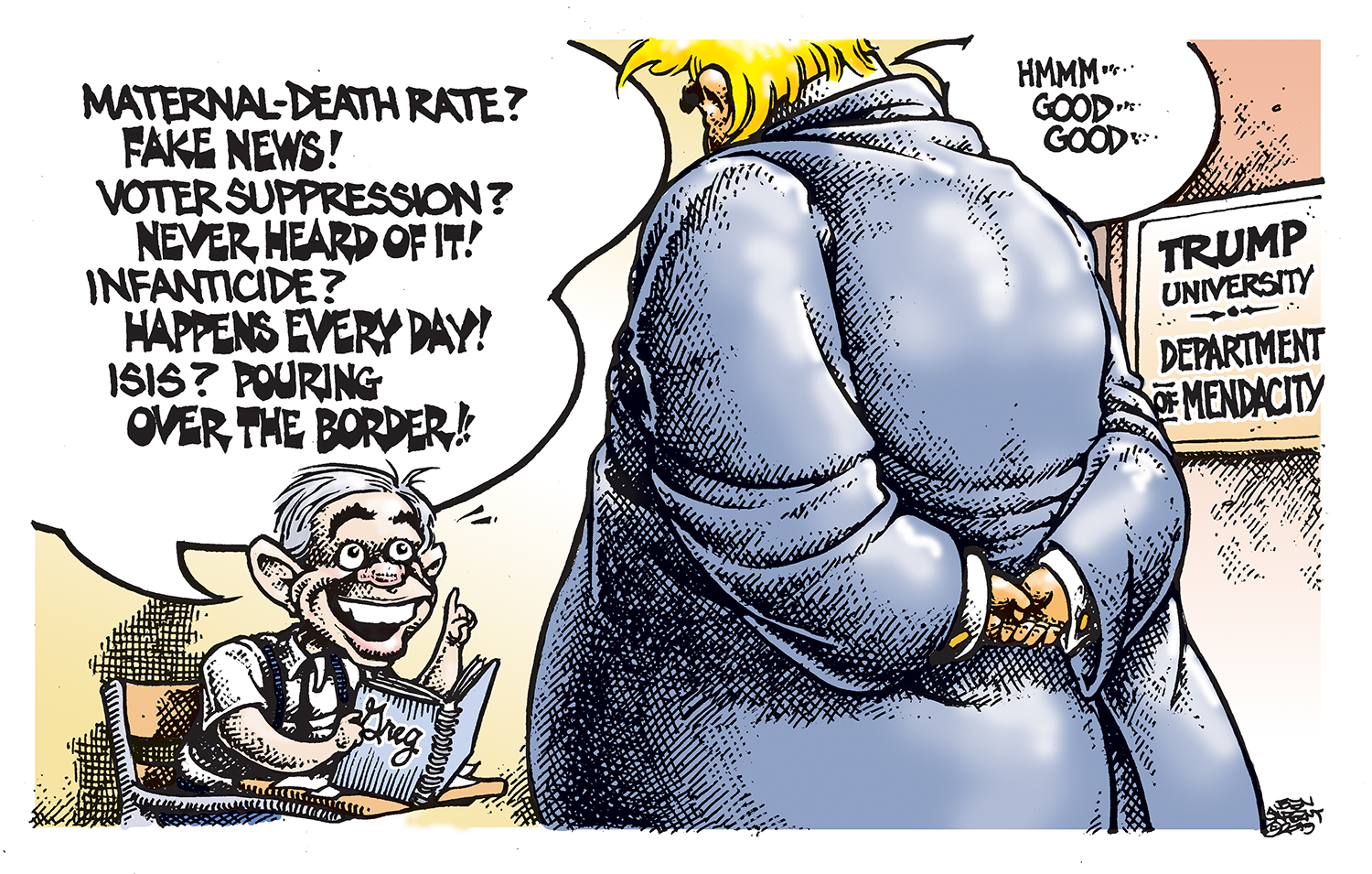
Migrant Deaths Are a Feature—Not a Bug—of U.S. Immigration Policy
Governor Greg Abbott says he can make coming to the U.S. more miserable than being smuggled in the back of a tractor-trailer.
Little more than a week after a horrific smuggling attempt left 53 people dead in San Antonio, Governor Greg Abbott promised a new border security strategy that doubles down on a century of policies that drive people to take dangerous routes into the United States.
Abbott’s new approach, which directs the Texas National Guard and Department of Public Safety to transport people they think are undocumented to U.S.-Mexico border crossings, will face court challenges and may end up being as much a publicity stunt as his promise to bus immigrants to Washington, D.C. But it highlights just how one-track the conversation about immigration is.
In his July executive order, Abbott invoked the 53 deaths in San Antonio, writing that “an immigrant’s journey to the United States can even prove fatal” and suggesting his border security measures would discourage unauthorized immigration.
Whether it’s President Joe Biden’s continued use of Title 42—a Trump administration holdover that allows Border Patrol to kick people out of the country quickly; former President Donald Trump’s family separation policy; former President Barack Obama’s family detention centers; former President George W. Bush’s wall; former President Bill Clinton’s deportation hearings on Coast Guard vessels in the Caribbean; or former President Dwight D. Eisenhower’s forced marches through the South Texas brushland, the U.S. immigration enforcement system has operated under a single premise since the creation of the Border Patrol in 1924: deterrence. It’s the idea we can somehow make coming to this country more miserable than the natural disasters, civil wars, gang violence, and economic hardship that displace people in the first place.
The results are deadly: Just days after someone called 911 on June 27 about the trailer full of dead and dying people in San Antonio, four people died as law enforcement officials pursued a smuggler north of Laredo. In 2018, five people died in another fatal pursuit of a human smuggler in Dimmit County. San Antonio’s last “trailer of death” incident in July 2017 left 10 people dead under circumstances remarkably similar to last month’s tragedy. In 2012, a smuggler lost control of an overloaded super duty pickup and careened off the highway between Beeville and Goliad, killing 22. The driver of a tractor-trailer left 18 people locked inside to die near Victoria in 2003. A train struck and killed six people from Mexico in 1998 in Kenedy County. A decade earlier, 18 people died locked inside a boxcar 90 miles east of El Paso. Another train near Kingsville killed five immigrants as they walked on a narrow railroad trestle in 1984.
Those are just the Texas incidents with a high enough body count to garner headlines (the Goliad and Dimmit County incidents barely registered with national media, and the wreck near Laredo drew attention only after San Antonio’s tragedy). There are many more horrific tales from Mexico, Central America, Arizona, and the Caribbean Sea—not to mention the people who drown in the Rio Grande or in irrigation canals, succumb to heat exhaustion hiking through the desert in the summer, die of hypothermia in the winter, or perish in vehicle collisions.
Many people already know the risks, said Elizabeth Almanza, an accredited representative with the nonprofit American Gateways who represents survivors of both the 2017 and 2022 trailers. Almanza’s own father would come to the U.S. in the 1970s, sometimes wading the Rio Grande, sometimes strapping himself to the underside of a train, to earn money he sent back to his large family living in an overcrowded apartment in Monterrey, Mexico. He knew he risked his life every time he crossed the parched South Texas brushlands or crawled under a freight train, Almanza said. He learned to travel at night, drink water from cacti, and memorize train schedules.
“Human survival kicks in,” she said. “If there’s a need to sustain your family, you’re going to go for it.”

As bodies were strewn across the narrow road on the city’s South Side that Monday night, court records show agents used mobile fingerprint scanners to identify 31 of the dead, suggesting they’d previously been in U.S. custody. ICE wouldn’t comment on whether they had been previously deported or enrolled in the euphemistically named Migrant Protection Protocols, which make immigrants await asylum hearings in camps in cartel-controlled border cities. We’ll learn more as reporters go through the grim task of interviewing family members and telling the stories of those who died.
Trying to tie long-term trends, or even one horrific incident, to a specific policy is difficult. The Department of Homeland Security (DHS) has admitted it struggles to analyze the impacts of its own “prevention through deterrence,” made official policy in 1994 by the Border Patrol. The stated goal is to limit migration—including those seeking asylum—at ports of entry. More than 7,500 people have died attempting to cross the border since 1998, primarily from heat exhaustion, according to Human Rights Watch.
Researchers say the cumulative impact of deterrence policies is that they push people into more dangerous routes to the U.S. This country’s immigration laws became more restrictive throughout the 20th century, and the resources devoted to border security have increased into the 2000s. In his 2015 “ethnography of death” in Arizona, the anthropologist Jason De León described “a security apparatus that transparently seeks to deter them through pain, suffering, and death.”
Those policies are trying to deter people fleeing pain, suffering, and death in their home countries, said Guerline Jozef, the director of Haitian Bridge Alliance, a nonprofit that provides support to Haitian immigrants in the U.S. Jozef had recently returned to her home in California from the funerals of 11 Haitians in Puerto Rico who drowned trying to reach the U.S. when she learned about the San Antonio tragedy. In a phone interview, Jozef borrowed from the British-Somali poet Warsan Shire, who once wrote, “no one leaves home unless home is the mouth of a shark.”
“When home is the mouth of the shark, you have to leave, you have to flee, to the unknown, because you have no other choice,” Jozef said. “So there is no deterrent practice you will find to stop people from searching for safety. And for the U.S. to create those policies is inhumane and unacceptable.”
In 2018, Trump’s Justice Department began charging all immigrant parents with a misdemeanor for illegally crossing the border. The brief detention on federal charges wasn’t the deterrent, though: Then, the U.S. government made it incredibly difficult for families to reunite after they were separated for brief court appearances, even though many parents didn’t face jail time.
“The family separation was pretty close to that,” Almanza said when asked if there was a policy harsh enough to really deter people from crossing the border illegally. “I think that scared a lot of these families coming in, which I think was the intent.”
“They come to America trusting, looking for a better life, and then this happens to them,” she added. “I’ve been doing this since 1998. I’ve seen changes in law. I would never have thought something like this would happen in immigration.”
But if Trump found a deterrent that traumatized people more than the journey to the U.S., it went too far even for him. In June 2018, after a little more than a month, he canceled the policy in the face of public backlash.
Other deterrence policies continued. In 2019, Trump followed up with the Migrant Protection Protocols (MPP), a program that requires immigrants to await their U.S. asylum hearings in violence-plagued Mexican border towns. Like so many deterrence policies, MPP—or Remain in Mexico, as it’s more widely known—didn’t rely on the government to scare immigrants away. In his book, De León described the Border Patrol outsourcing deterrence to the harsh sun and dry terrain of the Arizona desert. MPP outsourced deterrence to drug cartel members who rob migrants and kidnap them for ransom. More than 71,000 people were enrolled in the program during the Trump administration.
Shortly after COVID-19 reached the U.S., the Trump administration invoked Title 42, a public health law that allows immigration officials to kick people out of the country without hearing their asylum claims.
When he took office last year, Biden began a modest rollback of Trump’s draconian immigration policies. He quickly halted MPP, but efforts to end the program were tied up in court until June, when the Supreme Court ruled Biden could terminate it.
The Biden administration didn’t try to end Title 42 until April of this year, although a judge has ordered it kept in place. This fiscal year, Border Patrol agents have used Title 42 to expel 828,232 people without giving them the opportunity to request asylum. That policy was on full display last fall, when 15,000 people from Haiti arrived in Ciudad Acuña, Mexico, and tried to cross into Del Rio. The image of Border Patrol agents on horseback swinging their reigns and charging toward people on the river’s edge became so indelible, it’s now featured on a “challenge coin” being marketed to law enforcement.
That means thousands of people from Haiti decided to come to the U.S. during a period of border enforcement policy that, while arguably not as strict as what was in place from 2018 to 2020, is one of the most stringent in the country’s history. DHS eventually used Title 42 to fly 10,000 people back to Haiti without hearing their asylum claims, something that would not have happened five, 10, or 20 years ago.
Jozef was in Del Rio and watched as people were loaded onto buses and whisked off to deportation flights. Others were forced back into Mexico. Within days, the makeshift internment camp under Del Rio’s international bridge was gone.

“The reality is people who are coming to the U.S.-Mexico border are in search of protection,” Jozef said. “We can use Haiti as a clear example. We saw an increased number of people fleeing Haiti due to extreme political turmoil on the ground, extreme gang violence, the assassination of the president, creating mass migration, forcing people to leave.”
The Biden administration has proposed an administrative overhaul of the asylum system, which advocates say will likely be an improvement. But he’s received criticism for keeping Title 42 in place as long as he has.
“President Biden, in his statement, blamed this on smugglers and human traffickers,” Jozef said of the 53 deaths in San Antonio. “But in reality, those people were forced to deal with the smugglers and human traffickers because President Biden and his administration still have yet to create a safe way for people to have access to asylum.”
There’s a zeitgeist element to U.S. immigration. This country is home to more immigrants than any other nation, and the American Dream continues to loom large in the imagination of those abroad. We also have record low unemployment while sitting on the doorstep of poor and deeply troubled neighbors. We incarcerate a larger percentage of our population than any other country, dooming many to a life of recidivism and struggle to find employment, increasing the demand for foreign labor.
For people trying to come here, the immigration system often seems illogical. Sometimes, you can request asylum at international crossings. The law says you can cross the border illegally and still request asylum, but sometimes you’re sent to Mexico—even if you’ve never lived there. Sometimes, when you get sent to Mexico, you’re given a court date in the U.S. and told to wait for it south of the border. Sometimes, if you’re from a certain country, you’re allowed to enter the U.S. under something called “parole.” Sometimes, when you cross the border illegally, you’re given a notice to appear before an immigration judge and entered into a backlogged court system, then sent on your way. For people who can do it “the right way,” the wait for a visa can be yearslong.
Immigration restrictionists are correct when they point out the vast majority of people from Mexico and Central America will not meet the narrow criteria for asylum, even if U.S. law grants them the right to have their requests heard. DHS can, and has, granted Temporary Protected Status—a reprieve from deportation for immigrants in the U.S. based on emergencies in their home countries. And the U.S. offers refugee status, but unlike asylum, it’s only available if you apply abroad, and the Biden and Trump administrations have admitted record low numbers of refugees. Biden could make administrative changes allowing more people to enter the U.S. legally, but accommodating the number of people currently trying to come here would require broad changes to immigration law. Along with the more than 800,000 people expelled this year under Title 42, Border Patrol agents have deported another 805,872 through expedited removal, a process that allows deportations without court hearings but during which agents are supposed to let people claim asylum.
“The different policies that fall within this idea of deterrence are by, and large, not effective and are not really addressing the root causes of migration.”
For two decades now, lawmakers have debated “comprehensive immigration reform”—omnibus legislative proposals that usually involve some sort of expansion of visas, legalization of people who are here already, and more money for border security. The demand for cheap labor has driven migration to this country for centuries, yet we currently don’t have a system for legal immigration that meets that demand. Implementing domestic policies that reduce arrests and recidivism would increase the U.S. job force, potentially reducing the need for undocumented workers. And reversing decades of U.S. foreign policy that has undermined democracy and the rule of law for our neighbors would allow people to stay in their home countries and find peace and prosperity. Those are all long-term solutions that serve the U.S.’s own interests.
What about the people coming here now, not all of whom are part of the labor market or are eligible for asylum under our current laws? Sara Ramey, the executive director of the Migrant Center for Human Rights, a San Antonio nonprofit providing immigrants free and low-cost legal representation, called for expanding who’s eligible under U.S. asylum laws, which were written in the wake of the Second World War. She suggested adopting something like the European Union’s Temporary Protection, which is more expansive and provides more access to benefits than the U.S.’s Temporary Protected Status. Loosening immigration restrictions has the potential to draw more people to the border. And creating a system that lets the hundreds of thousands of people trying to enter the U.S. every year cross the border in an orderly fashion while screening them in humane conditions and not overwhelming border communities would be a massive undertaking. But Ramey’s position is that the U.S. needs to offer a pathway other than the dark interior of a tractor-trailer.
“The different policies that fall within this idea of deterrence are by, and large, not effective and are not really addressing the root causes of migration,” Ramey said. “I say ‘root causes’ not just in the sense of the danger and desperation people are fleeing from, but in the sense of our laws not having many viable ways for people to come into the country.”



